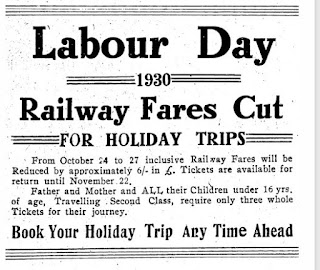While visiting the Thames Small Gauge Railway, I noticed a beautiful old photo of the Thames School of Mines, on an information board.

"This photo from 1900 shows, from left to right, the Mineralogical Museum, the Battery Room and the classroom buildings of the Thames School of Mines.The site is a Māori urupā(burial site) part of which was gifted to the Wesleyan Church in 1868. In 1886, the School of Mines bought the land and the 1869 Sunday School building. Over time they added the buildings shown here. Two additions after 1900 created the complex you see today."
- The Urupa was located at the corner of Cochrane and Brown Streets.
- The Urupa was the burial ground for the Tarakonaiti Pa.
- The nearby roads and several houses, as well as the School of Mines are located on the Urupa.
- The area covers blocks Te Kauaeranga 12A and 13A.
- The land was surveyed in 1868 and no roads were to be laid in the area.
- The land was gifted by the Maori landowners to the Wesleyan Church, for that purpose.
- In 1877 the church tried to sell the land to the Auckland Education Board.
- Hohepa Paraone and Hone Te Huiraukura petitioned Parliament to try and stop the sale.
- The petition was unsuccessful and after ten years of legislation the land was officially sold in 1886 for the purpose of the Thames School of Mines.
Report on Petition of Hohepa Paraone and Another.Petitioners, who are Natives of the Thames District, state they conveyed a piece of land at the Thames to the Wesleyan body, as they understood, for religious purposes only, but that they learn now with deep regret that it is proposed to sell it to the Education Board in Auckland, and they pray for such relief as may insure that the land in question shall be devoted to the purpose originally intended.I am directed to report as follows:—That, while the Committee have some reason to think that the proposed sale or transfer of the land in question is not in accordance with the intention under which it was originally given, the Committee do not feel able to recommend any course to the House which would have the effect of depriving the trustees of legal rights which are not denied by the petitioners.
E whakaaro ana ano te Komiti he tika kahore i whakaritea kia taea te hoko te tuku ke atu ranei taua wahi i runga i nga whakaritenga i te tukunga o taua wahi i te tuatahi. Engari e mea ana te Komiti e kore e taea e ratou te mahi he tikanga ma te Whare e kore ai e taea e nga kai-tiaki te mahi i nga tikanga kua hoatu kia ratou e te ture kaore nei i te whaka hengia e nga kai inoi.
John Bryce,Chairman.30th October, 1877.


















































